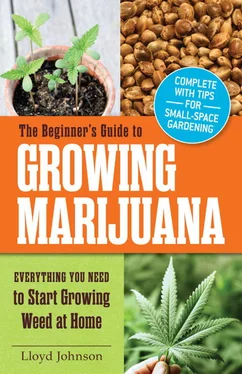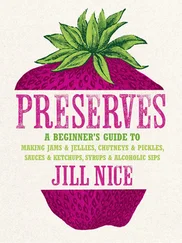Be very careful to label the clone with strain and date, and write down any other information you’ve acquired in your grow book (see Chapter 14: Recordkeeping). You may think you will remember everything at a later date, but you might miss important details and information. You will be using this information some years down the road if you continue as a cannabis grower. Good recordkeeping is essential, not only for your own needs, but for the credibility of your strains’ provenance. To serious growers, correct identification of a plant’s genetics is essential; the effort and expense of growing high-grade cannabis precludes operating from guesswork. The plant should be labeled from cutting to clone to plant and to hanging, drying plant; in other words, at all times .
Keep It Simple
A plastic label marked with indelible pen should be either stuck in the soil at the base of the plant or affixed with a twist tie to an axial branch. This way, you’ll always know what you are dealing with.
Perhaps clones are not available to you, or you just like the idea of growing your plants from seeds. Many people have small bags of seeds they’ve kept over the years, possibly labeled, probably not. If these are your only option, it is not the worst thing in the world; you kept those seeds for a reason, most likely because you enjoyed the cannabis it came from (though you might have cursed at the time if you spent good money for sinsemilla, or seedless, cannabis).
If you are on a tight budget, have no seeds of your own, and are shocked by commercially produced seed prices, perhaps a nongrowing friend has some seeds. If your friend generally consumes what you consider to be high-end cannabis, he may contribute something rather special. Growers call these sorts of seeds “randoms” or sometimes “unknown soldiers.” This is somewhat akin to buying a surprise package or an abandoned storage locker at auction; you have no real idea of what you will get, but sometimes you end up with something very nice.
Ideally, however, you will get your seeds from a known source, a breeder or grower you know personally or a trusted mail order house in Canada or Amsterdam. If you plan to grow outdoors, locally bred seed from outdoor plants has the advantage of already being acclimated to your home growing conditions.
Keep It Simple
While expensive, mail order seeds generally are very good quality and of known provenance. Most seeds come from Amsterdam or Canada. If you are especially fond of a popular commercial strain, you can generally acquire it by mail order.
Feminized Seed
Some mail order strains are feminized, or guaranteed to be female plants. Feminized cannabis seeds start with selected female clones that are manipulated environmentally to produce male flowers and pollen and bred back to themselves. Feminized seeds are difficult to produce but are purported to deliver all (99 percent) female plants. Feminized seeds also are believed to produce genetically stable plants, which is useful in a breeding program; however, some growers report hermaphrodism as a problem. If you plan to use feminized seeds, it is better to purchase them from a reputable seed bank, as most will guarantee that the seed will produce females.
Seed Storage
To keep seeds viable, store them in a dry, dark, cool place and in dry, airtight glass containers. Make certain they are clearly labeled with their source and the year of production. Although it is advisable to use fresh seed when possible, cannabis seeds are very strong and long lasting.
Although definitely not the best practice, because viability is affected by aging, growers have been known to germinate seeds as old as twenty years, if not older. Ideally, you will use the seed within three years of production. As the seed ages, a smaller proportion will germinate successfully.
Growers germinate very old seed (as in twenty-plus years) out of interest, just for fun, and sometimes because they have no other choice. One grower reported amazement at the nostalgic recognition and feeling of reuniting with the long-ago plant via its daughter.
As noted, using old seed is not a best practice, but it is sometimes useful if a hybrid strain starts manifesting unwanted characteristics. The breeder can go back a few generations and rework the strain forward by introducing desired characteristics from another line. It is also comforting to know that you, as the breeder, can revisit a particularly good year by germinating and propagating the siblings of superior plants.
Selecting Seeds
Unless you have paid big dollars for feminized seed, plan on starting twice as many seeds as the final number of female plants you hope to raise to fruition. The ratio of males to females is generally 1:1. Of course, you are dealing with living entities, so this will vary.
Examine your seeds carefully under magnification; a jeweler’s loupe or handheld magnifying glass will work fine. Remove and dispose of any seeds that are cracked or have holes. Check for the most mature seeds. Depending on the strains you are working with, the mature seeds will be either very dark brown with lighter brown striping, or a strong green-gray with brown striping. Pale whitish green seeds with no striping are immature and should be discarded.
Germinating Seed
Seeds require moisture, warmth, and darkness for successful germination. Before you start soaking your seeds, you need to plan ahead so that you can consistently provide all three. To prepare your seed-soaking area, assess how well it meets germination requirements; the area should be dark and warm, 65ºF–80ºF, ideally 70ºF. Some growers use seed-starting mats that maintain an ideal temperature, but a warm closet or kitchen cupboard (on an inside wall) will usually be fine.
Keep It Simple
An infrared laser surface thermometer is an invaluable and inexpensive tool. These are sold for cooks, but they take a lot of worry out of seed starting. You can check temperature instantly and take steps to correct an environment that is too cold or too warm.
A foil-covered cookie sheet makes a good tray for small bowls or jars. If you are starting different strains, make certain your labels are prepared and affixed to each tray or bowl so you can keep track of which seed is which strain. You will need a convenient light source, as you will be checking the seeds frequently for germination, as well as monitoring moisture. You do not want the seeds to dry out.
Some growers use plastic zip-top bags filled with clean water for germination. These have an advantage, as you can turn the bag and examine the seeds for activity without actually touching the seeds. Also, since they are sealed, less water is lost to evaporation, and it protects against having your seeds dry out. On the other hand, the bags make it more difficult to remove and plant a seed that has cracked and shown a tiny white root tip (usually referred to as having “tailed”) since all the seed will not tail at once.
Many growers use small water glasses or jam jars and float the seeds in clean water. Others use small, shallow bowls with squares of paper towel cut to fit. The seeds sit on moistened paper towels and are covered by a thin layer of damp towels on top. The top layer is easily lifted to check the seeds. The paper towel method mimics nature more closely (simulating the damp soil a seed would have fallen to) and is the easiest for removing germinated seeds for planting.
Remember, at this point you will have started your grow book and will note the date you start soaking your seeds. Fresh seeds generally tail within twenty-four to forty-eight hours, but some, particularly older seeds, can take up to a week or even ten days.
Читать дальше












